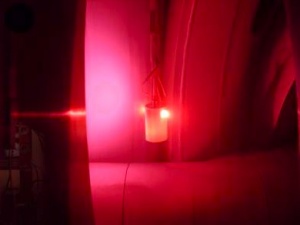TJ-II:Plasma Wall Interaction: Difference between revisions
Jump to navigation
Jump to search
No edit summary |
No edit summary |
||
| Line 1: | Line 1: | ||
To condition the wall of the [[TJ-II]] vacuum vessel, a number of techniques is used. | To condition the wall of the [[TJ-II]] vacuum vessel, a number of techniques is used, | ||
such as a baking system. | |||
<ref>[http://dx.doi.org/10.1109/FUSION.1999.849826 R. Carrasco, '' Hybrid baking system for the vacuum vessel of the Spanishstellarator TJ-II'', Proc. 18<sup>th</sup> Symposium on Fusion Engineering (1999) 231-234]</ref> | |||
== Glow Discharge Cleaning == | == Glow Discharge Cleaning == | ||
Revision as of 22:52, 20 August 2009
To condition the wall of the TJ-II vacuum vessel, a number of techniques is used, such as a baking system. [1]
Glow Discharge Cleaning
Glow discharge cleaning is routinely used at TJ-II. [2] [3]
Limiters
TJ-II is fitted with two mobile limiters. Nevertheless, the main interaction between the plasma and the wall occurs at the central "groove".
Wall conditioning
Careful control of wall conditions is essential for successful operation. [4]
The walls can be coated by various materials, using a set of 4 evaporation ovens: two fixed and two mounted on retractable manipulators. In the course of time, TJ-II has been operated with the following types of wall:
TJ-II was the first stellarator to be operated with Lithium-coated walls. The lithium coating has led to much improved density control.
References
- ↑ R. Carrasco, Hybrid baking system for the vacuum vessel of the Spanishstellarator TJ-II, Proc. 18th Symposium on Fusion Engineering (1999) 231-234
- ↑ D. Tafalla and F.L. Tabarés, Journal of Nuclear Materials 290-293 (2001) 1195-1198
- ↑ D. Tafalla and F.L. Tabarés, Vacuum 64, Issues 3-4 (2002) 411-415
- ↑ F.L. Tabarés et al, Journal of Nuclear Materials 290-293 (2001) 748-752
- ↑ F.L. Tabarés et al, Plasma Phys. Control. Fusion 43 (2001) 1023-1037
- ↑ D. Tafalla and F.L. Tabarés, Vacuum 67, Issues 3-4 (2002) 393-397
- ↑ F.L. Tabarés at al, Plasma Phys. Control. Fusion 50 (2008) 124051
- ↑ J. Sánchez et al, Journal of Nuclear Materials 390-391 (2009) 852-857
